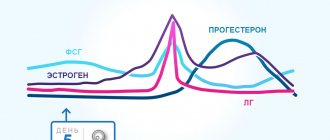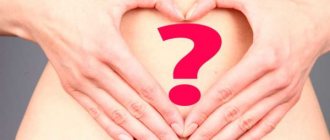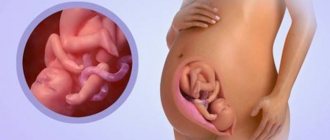Let's understand the term "ovulation"
The duration of the menstrual cycle is determined from the first day of the previous menstruation to the first day of the next. Its duration varies and normally ranges from 21 to 35 days. The ideal menstrual cycle is considered to be a cycle lasting 28 days, which corresponds to a full lunar cycle. The menstrual cycle consists of several phases:
Follicular phase
The follicular phase is caused by the action of estrogens, under the influence of which a dominant follicle is determined in the ovary, in which the future egg matures. This phase lasts an average of 12–18 days, depending on the length of the cycle. With a 28-day period it is 14 days. Towards the end of the follicular phase, the dominant follicle has reached its maximum development, is tense and is preparing to burst.
Ovulatory phase
The shortest phase of the menstrual cycle, its duration is 12 – 36 hours. During this phase, estrogen levels drop, causing the main follicle to burst and release a mature egg, ready for fertilization. What is characteristic is that it is during the ovulatory phase that the level of both estrogen and progesterone is quite low (estrogens are no longer synthesized, since the dominant follicle and egg have already “matured”, and progesterone is not yet produced in sufficient quantities under the influence of luteinizing hormone due to the still unformed corpus luteum in place of the main follicle).
Luteal phase
The synthesis of progesterone increases, under the influence of which proliferative processes occur in the uterine mucosa, preparing it for implantation of a fertilized egg. In the case of unsuccessful fertilization, by the end of the luteal phase, the level of progesterone decreases (the corpus luteum of menstruation dies) and the functional layer of the endometrium is rejected, which is called menstruation.
So, ovulation is nothing more than the process of the release of a mature egg from the dominant follicle at the moment of its rupture. And painful ovulation is called ovulatory syndrome or Mittelschmertz syndrome.
Signs of ovulation
Ovulation (from the Latin word for “egg”) has characteristic signs, and every woman experiencing discomfort or pain associated with it can almost accurately determine its onset:
Pain in the right side or left
Pain occurs on a certain side, depending on which ovary “works” in a given menstrual cycle (most often, right-sided pain is observed, which is associated with better blood supply to the right ovary and its innervation, as well as with the close proximity of the appendix).
As a rule, the pain is minor and may cause only mild discomfort. In some cases, women characterize the pain as cutting, stabbing or cramping. This feeling does not last long, from an hour to a day or two. The intensity of pain depends on:
- character - emotional representatives of the fairer sex feel pain more clearly
- the presence of gynecological diseases contributes to increased pain
- pain sensitivity threshold - the higher it is, the less pain a woman experiences during ovulation.
Thus, ovulation itself is short-lived, and pain in the lower abdomen after ovulation may persist for one to two days. Since only one ovary is involved in ovulation in each menstrual cycle, they function alternately, that is, pain can be on the right in one month and on the left in another.
In rare cases, when both ovaries are involved in the work, 2 eggs mature at the same time, which, if fertilized successfully, leads to multiple pregnancies. In such a situation, a woman feels pain on both sides or a diffuse aching pain in the lower abdomen.
Increased libido
Libido, or sexual desire, increases somewhat during the period of ovulation, which is inherent in nature itself (after all, ovulation is the most favorable moment for conception, and therefore for procreation).
Discharge
On the eve of ovulation, at the moment of its completion, and for another couple of days, the nature of vaginal discharge changes. They become more liquid, stretchy and look similar to egg white. These changes in secretions are necessary to create favorable conditions for the penetration of sperm into the uterine cavity to fertilize a mature egg. The liquid consistency of the discharge in the slightly expanded cervical canal facilitates the passage of the “live animals” into the uterus.
Changes in discharge color
During ovulation and some time after it, the color of the discharge may also change. They take on a pinkish tint or a few drops of blood are found on the underwear (see spotting in the middle of the cycle). This is due to a slight detachment of the endometrium (estrogens are no longer produced, and progesterone has not yet begun to be synthesized).
Pain in the mammary glands
Pain or tenderness of the breasts may occur during ovulation (see pain in the mammary glands), which is associated with the initial preparation of the mammary glands for pregnancy and lactation. Such pain (mastodynia) is short-lived and stops by the time the corpus luteum forms.
Causes
There are several causes of pain during ovulation. Before it begins to emerge from the follicle, it must mature and significantly increase in size.
- The large “dimensions” of the follicle stretch the ovarian capsule, which explains the occurrence of pain before ovulation.
- After the dominant follicle has reached the “desired condition,” it bursts and a ready-made egg is released into the abdominal cavity.
- At the moment of rupture of the follicle, in addition to the egg, a certain amount of fluid is poured into the abdominal cavity, which irritates the parietal peritoneum. In addition, the ovarian capsule is damaged, in which small blood vessels burst, resulting in even a small amount of blood entering the abdominal cavity, which also irritates the peritoneum.
- Such nagging pain after ovulation can bother a woman for 12 to 48 hours. But then the blood and follicular fluid in the abdomen are absorbed and the pain syndrome disappears.
- And since at the moment the egg appears in the abdominal cavity, the fallopian tubes begin to peristalt (contract) more strongly in order to have time to capture a viable egg and ensure that it meets the sperm, pain can be maintained by this process.
- An indirect sign of a possible future pregnancy is pain in the middle of the cycle.
But in some cases, the pain syndrome at the time of ovulation is more pronounced, which is due not only to the threshold of pain sensitivity, but also to the presence of certain gynecological diseases, for example:
- adhesive disease of the pelvis, which may be caused by chronic inflammation, a history of surgery or endometriosis
- adhesions do not allow the tubes to contract calmly and tighten the ovary, and in some cases cause compaction of its capsule, all this increases the severity of pain.
Ovulatory pain - normal or pathological
It would seem that pain during ovulation has every reason to develop, because the follicle containing the egg first grows to a fairly large size and then bursts, and the nerve endings approaching the ovary react to both of these processes. But usually only those who have a low pain threshold feel this normally. That is, if a woman does not tolerate pain well from childhood and may even lose consciousness because of it, she should not be alarmed by the pain of the ovulatory phase, unless 5 conditions are met:
p, blockquote 9,0,0,0,0 —>
- Ovulation is determined by tests: determination of basal temperature (its decline was noted on the previous day, and on this day a sharp rise is visible), an ovulation test or ultrasound folliculometry.
- It hurts on one side (for example, the left ovary), since in each cycle the dominant follicle, that is, the one that prepares the egg for fertilization, develops only in one ovary. Each cycle, the “working” ovary may change, but it may happen that for several months in a row the pain is felt only on one side.
- There are no pathological symptoms: dizziness, vomiting (mild nausea is allowed for 2-3 hours), weakness, or a feeling of unreality of what is happening.
- The temperature remains up to 37°C, the maximum rises to 37.3-37.4°C.
- Other symptoms of ovulation are also noted: swelling and tenderness of the mammary glands, a change in the nature of vaginal discharge to the appearance of raw egg white, and increased sexual desire. There may be a discharge of a small amount of blood (usually in the form of brown or yellowish mucus), which is associated with the detachment of a small area of the endometrium due to a sharp drop in estrogen levels.
Blood vessels approach the shell of the follicle in which the egg has matured - they provide nutrition to this structure. Therefore, when it bursts, the vessels rupture, and a small volume of blood flows into the abdominal cavity. A small amount of fluid in which the oocyte was previously located is also released. These fluids are an irritant to the peritoneal nerve endings, and therefore cause pain during ovulation. In this case, the pain is felt on one side and can migrate from the left or right to the lower abdomen - the suprapubic region. If blood flows into the space between the vagina and rectum, nagging pain is felt not above the pubis, but in the lumbar region.
p, blockquote 10,0,1,0,0 —>
When a woman has a low pain threshold and has 5 of the above signs, then pain in response to bleeding from the follicle vessels is a normal phenomenon that does not require any emergency measures. If the pain syndrome is very intense, or does not occupy the lower abdomen or lower back, but radiates to the left or right side, you need to be urgently examined for three conditions.
Types of ovulation
There are several types of ovulation:
Premature ovulation is the maturation and release of an egg from the follicle not in the middle of the cycle, but much earlier and can be caused by several factors:
- excessively violent sexual intercourse (see causes of pain during sexual intercourse);
- increased physical activity or heavy lifting;
- stress and strong emotional experiences;
- various diseases, including gynecological ones;
- hormonal disorders and endocrine pathology.
The etiology of late ovulation includes various hormonal problems, including menstrual irregularities.
In connection with the described types of ovulation, pain, accordingly, does not occur, as is customary, in the middle of the cycle, but much earlier or, on the contrary, later, which can become a cause for concern for a woman (see also symptoms of premenstrual syndrome). Therefore, an indirect sign of a possible future pregnancy is pain in the middle of the cycle.
Anovulation
Speaking about ovulation, one cannot help but touch upon the problem of its absence or anovulation. Normally, anovulation is observed in pregnant women and premenopausal and menopausal women. And, of course, ovulation cannot occur while taking hormonal birth control pills.
If a woman of reproductive age does not ovulate for several cycles in a row (2 or more), she should start sounding the alarm, because no ovulation - no egg - no possibility of getting pregnant.
As a rule, the cause of anovulation is hormonal imbalances in the body, which, with appropriate treatment, are stopped and the woman has a chance to become a mother. To clarify the date of ovulation, you can use ovulation tests or undergo an ultrasound, where the doctor will accurately see the mature follicle and the release of the egg from it (of course, ultrasound is performed several times during the period of expected ovulation).
Prevention of pain during ovulation
If a woman has pain in her ovary during ovulation, she should reduce physical and nervous stress and, whenever possible, spend this time in a state of complete rest, lying on her stomach. You can use a heating pad, but only if you are absolutely sure that the feeling of discomfort is not a symptom of an inflammatory disease. If the pain syndrome is severely tolerated, painkillers are used, which are selected by the doctor. Drinking plenty of fluids and walking in the fresh air also helps relieve excessive discomfort. If the pain is severe on a monthly basis, it is possible to use hormonal drugs, but only a doctor can prescribe their use.
How to make it easier
No matter how sure a woman is that the pain that appears in the right or left lower abdomen is associated with ovulation, she should not self-medicate, but rather consult a doctor. After all, any pathology, not only gynecological, can cause pain, which accidentally coincides with the middle of the cycle.
During the examination, the specialist will rule out other causes of pain and recommend the optimal treatment (see also how to reduce pain during menstruation).
- If ovulatory syndrome bothers a woman every menstrual cycle, she is advised to relax as much as possible on the days of ovulation, eliminate stressful situations and adhere to a certain diet.
- In therapeutic nutrition, they limit dishes and products that increase the load on the gastrointestinal tract, increase intestinal motility, which aggravates pain, cause flatulence and excite the central nervous system. These are primarily spicy and fatty foods, legumes and white cabbage, chocolate, coffee and strong tea.
- Warm baths with aromatic oils or medicinal herbs help relieve pain. heat descends to the lower abdomen, which reduces contraction of the uterus and tubes and relieves pain, but only if acute infectious and surgical diseases are excluded.
- Of the painkillers of choice, non-steroidal anti-inflammatory drugs are the method of choice, which block the synthesis of prostaglandins, relieve pain and inflammation (ibuprofen, indomethacin, naproxen, ketoprofen).
- Taking antispasmodics (no-shpa, spazgan, spasmalgon) is also effective.
With constant ovulatory syndrome, the gynecologist may recommend taking oral contraceptives (pros and cons of taking them), which, by blocking ovulation, prevent the occurrence of pain. But, if a woman wants to get pregnant, their use is excluded, and it is also not permissible to use a heating pad on the lower abdomen and take any medications on the days of ovulation, as this may affect the quality of the egg.
When to sound the alarm
You should consult a doctor as soon as possible if you experience severe pain in the lower abdomen and/or the following signs:
- the pain continues for more than two days (“it hurts for a week during ovulation” - a clear sign of the disease);
- the temperature has risen and lasts for more than an hour;
- nausea/vomiting occurred;
- bloody discharge from the genital tract appeared, regardless of its intensity;
- when taking drugs that stimulate ovulation;
- a history of acute gynecological diseases, surgeries, endometriosis;
- sudden fainting;
- progressive deterioration of the condition.
During the period of ovulation, a woman may experience pain of varying origins and intensity.
This is mainly due to changes in the female body during this period, the presence or absence of diseases of the reproductive system of each individual patient. Read more about the causes of pain in the sides during ovulation in this article.
Should I go to the doctor right away?
If discomfort persists a week after ovulation, this is a reason to be wary. In this case, you should pay attention to the accompanying symptoms - temperature, discharge. If such signs are present, you cannot hesitate, otherwise serious consequences may occur. Pain in the ovary after ovulation is not always associated with it - it can be caused by a ruptured cyst or a severe inflammatory process. Such conditions require immediate medical intervention.
To maintain health and prevent the development of serious diseases, you need to listen carefully to your body. If any suspicious symptoms appear, you should consult a doctor for examination. Only a specialist will be able to accurately determine the cause of pain in the ovary after ovulation or during another period of the cycle and prescribe adequate treatment.
Your couple carefully planned the pregnancy. You followed all the doctors' orders, passed all the necessary examinations and led an active sex life. But the most important question remains valid: how to recognize whether fertilization has occurred or not?
In fact, a woman’s body gives us many clues when conception occurs. Maybe there was no release of the egg, but life is already developing in the uterus? It is important to “read” the hints correctly. And if you feel a nagging pain in the lower abdomen, perhaps there is a reason for joy. After all, almost all women feel pain after ovulation as a sign of pregnancy.
Of course, you yourself cannot give a 100% guarantee that everything worked out and the baby is already there. It is necessary to exclude the possibility that the pain is due to an existing disease. To do this you need to visit a specialist. He will examine you and order some tests. This will help you figure out whether you have succeeded or whether you need to repeat everything all over again.
Pain during follicle maturation
During the maturation of the follicle, women often experience nagging pain in the right or left side; less often, this can be observed on both sides simultaneously. In general, experts believe that this is a normal phenomenon that can appear in each monthly cycle during the ovulatory period. In this case, the pain should last no more than a day, without a prolonged increase in temperature and a sharp deterioration in the patient’s condition . Otherwise, you must seek medical help.
Need for medical assistance
Pain in the lower abdomen is not always the norm. A woman should keep a calendar of her menstrual cycle to know whether the ovary hurts after ovulation, during it, or whether the discomfort is not associated with a specific phase. When the pain is mild, localized on one side, does not interfere with leading a normal lifestyle, coincides with the period of ovulation and lasts no more than 48 hours, then there is no cause for concern. You should immediately seek medical help if you have symptoms such as:
- abdominal wall tension;
- increased body temperature, nausea, vomiting;
- bilateral pain;
- urinary disturbance;
- severe pain intensity;
- bleeding from the vagina;
- lack of effect of painkillers.
Causes of discomfort
Such pain at different periods of the ovulatory cycle is caused by different reasons and factors, each of which can cause them both directly during ovulation and after it ends.
During the release of the egg
In the absence of gynecological diseases, such sensations depend on the natural processes occurring in the woman’s body at this time and arise due to the following reasons:
- stretching of the ovarian capsule by the growing follicle;
- irritation of the nerve endings of the parietal peritoneum with fluid from the burst follicle;
- irritation of the peritoneum with blood from damaged small blood vessels of the ovarian capsule;
- strengthening the peristalsis of the fallopian tubes for faster capture of an egg ready for fertilization.
also a number of diseases that increase pain during ovulation, regardless of the pain threshold of a particular patient. Most often, this is adhesive disease of the pelvis, resulting from a chronic inflammatory process, surgical interventions in this area, and endometriosis.
In this case, adhesions prevent the normal contraction of the fallopian tubes, which in turn tighten the ovary or even cause compaction of its capsule, which significantly increases pain during the period of ovulation.
During the postovulation period
If we talk about the normal state of the body, then the presence of pain after ovulation is explained by postovulation syndrome , that is, a set of symptoms that arise after a mature egg enters the fallopian tube. The following symptoms are noted:
- deteriorated general condition of the patient;
- change in vaginal discharge;
- increased libido;
- bloating;
- emotional instability.
Normally, the pain of postovulation syndrome lasts no more than 2 - 3 days and passes after the absorption of fluid and blood poured into the abdominal cavity from the ruptured follicle, healing of the ovarian capsule and a decrease in the intensity of contractions of the fallopian tubes.
Causes of abdominal pain before ovulation
Sometimes a woman worries that she is experiencing pain before ovulation, but in fact, due to physiological or pathological reasons, the moment of release of the egg occurred earlier, that is, in fact, she is now ovulating.
Physiological reasons for the shift in the ovulatory phase include: stress, acute illnesses and exacerbation of chronic pathologies, time zone changes. Ovulation can also shift due to inflammatory diseases, endometriosis, and endocrine diseases that have developed in the uterine appendages (pathologies of the adrenal glands, hypothalamus, pituitary gland).
If your stomach hurts before ovulation, and this is clearly visible from the basal temperature graph or folliculometry data, the symptom indicates the presence of various pathologies:
- growing uterine fibroids, manifested, in addition to constant pain, by bleeding from the vagina during the intermenstrual period, as well as longer and heavier menstruation;
- the development, immediately before the release of the oocyte, of inflammation of the uterine appendages (salpingoophoritis), intestines or urinary organs, each of which is complemented by characteristic symptoms.
What are they talking about from different sides?
Depending on which side pain occurs during ovulation, we can talk about different processes occurring in a woman’s body.
On the right side
In a normal state of health, pain in the right side occurs during the release of the egg from the follicle of the right ovary and normally stops 1 to 2 days after this. If the pain persists after ovulation is completed, this may indicate the presence of various diseases localized on the right.
Ovulation pain is similar in nature and strength to the pain that occurs with appendicitis . Therefore, if after ovulation the pain on the right side does not stop and is accompanied by a prolonged increase in body temperature, you should consult a specialist to diagnose the cause of the pain.
From the left side
This suggests that in this monthly cycle, the left ovary is involved in the process of follicle maturation and oocyte release. Symptomatically, everything proceeds in the same way as on the right. If pain in the left side of the abdomen persists after ovulation, with accompanying disturbances in the functioning of the gastrointestinal tract, we can talk about the possible presence of not only gynecological diseases, but also inflammatory processes in the intestines.
What other signs of successful conception could there be?
The fetus tries to communicate its existence from the very first days of its existence. There are many of them, you just need to be able to notice them:
- Minor blood loss. They confuse girls who confuse them with menstruation. This symptom does not appear at the same time: it all depends on the structural features of the body. Usually the norm is 6-12 days. You can see drops of yellowish or brownish blood on your underwear. But here you need to be extremely careful - if the process lasts more than 3 days, rush to the gynecologist. Otherwise, there is a risk of involuntary abortion (miscarriage).
- A heaviness appeared in the lower abdomen. Discomfort appears in the pelvic area. These symptoms may appear in the first week. They indicate that the uterus has become hypersensitive, as well as changes that have occurred in it. Each body feels differently. Therefore, all patients named different pain thresholds. But almost all of them stated that during subsequent pregnancies the pain was much stronger.
- The breasts swelled and became more sensitive. This sign is characteristic of one of the stages of baby development. In the first week after fertilization has occurred, the breasts may become hypersensitive. Pain is also considered normal. But this sign is not mandatory. Some ladies claimed that in the first week after the birth of the fetus, no sensations were observed.
- Malaise, general weakness. Problems with well-being and bad mood can often accompany pregnancy. Immunity deterioration is also possible.
- Symptoms:
- slight malaise
- drowsiness
- rapid fatigue
- weakness
- Irregular menstruation (delay). Sometimes it is possible that menstruation occurs in 1 month of pregnancy, since up to 15 days the fertilized egg may not yet reach the uterus. But a repetition in the 2nd month indicates that there is a problem and you need to go to the doctor.
- Toxicosis. One of the first signs signaling that a miracle has occurred.
What ailments can be suspected?
In addition to the normal manifestations of pain during and after ovulation, it should be noted that they can be a sign of serious internal diseases in the patient’s body. You should pay attention to diseases that may cause acute pain.
- Ectopic pregnancy . Accompanied by bloody vaginal discharge, cramping attacks of pain, increased pain during walking and defecation.
- Ovarian diseases . Ovarian cyst and torsion of its legs, other ovarian tumors, apoplexy (rupture) of the ovary. In these cases, pain can occur on either side.
- Cyst rupture . Accompanied by cutting and pulling pain.
In addition, pain during ovulation is similar to pain during the following diseases:
- peritonitis;
- inflammation of the appendages;
- appendicitis;
- varicose veins of the pelvic area;
- call.
What diseases can be associated with pain in the side?
The onset of sudden severe pain may be a sign of an emergency. It is necessary to exclude pain on the sides in the following diseases:
- acute appendicitis;
- ovarian rupture;
- torsion of the cyst legs;
- acute inflammation of the appendages;
- disrupted ectopic pregnancy;
- intra-abdominal bleeding.
Constant abdominal pain, which intensifies with changes in body position, is inherent in the inflammatory process of the peritoneum. There is no need to endure acute pain. Lost time can cost your life.
How to alleviate the condition?
In the absence of medical contraindications, every woman can alleviate her condition at this time by adhering to simple recommendations:
- Increase sleep duration and minimize stress load on the body.
- Avoid active sports and reduce other physical activities.
- Increase the amount of fluid consumed per day.
- If you are sure that the pain is purely ovulatory, apply a heating pad on the desired side.
- Go on a diet that excludes fried, salty, spicy, fatty and sweet foods. In addition, it is recommended to give up coffee, chocolate and legumes for several days.
Medications
If your stomach hurts and pulls strongly enough, then you don’t need to endure it at all. Medicines that can be purchased without a prescription at any pharmacy will help relieve discomfort. For pain relief, it is recommended to take non-steroidal anti-inflammatory drugs :
- Ibuprofen.
- Indomethacin.
- Naproxen.
- Ketoprofen.
And to relieve pain caused by spasms they use:
If there is a constant ovulatory syndrome, a gynecologist may recommend taking oral contraceptives. However, for women planning a pregnancy, this method of facilitating the ovulatory period should be abandoned to preserve reproductive function in a natural state.
As you can see, pain in the side during the period of ovulation is a normal phenomenon for the female body during this period , in the absence of any pathological signs and symptoms. But if there is the slightest suspicion that the unpleasant sensations may be associated with some disease, then you should immediately consult a doctor in order to avoid many unpleasant consequences, even life-threatening as a result of acute pathologies.
Ovulation is the moment when a cell is released for possible fertilization. The process occurs almost in the middle of the female cycle. Each representative of the fair sex has different perceptions and sensations at this moment, which helps in determining the right day for conception. Let's try to understand the physiology of this phenomenon, and why a woman may experience certain unpleasant moments, including when her right side hurts during ovulation.
When is emergency help required?
If pain in the lower abdomen is accompanied by one of the following signs, a woman should immediately consult a doctor or call an ambulance:
- The pain lasts longer than two days;
- The patient's condition gradually worsens;
- There is a steady increase in temperature;
- Loss of consciousness;
- Nausea and vomiting;
- Acute gynecological diseases, surgeries and endometriosis in the past;
- Bloody discharge of varying intensity;
- The pain occurred after taking medications to stimulate ovulation.
Ovulation is the moment when a cell is released for possible fertilization. The process occurs almost in the middle of the female cycle. Each representative of the fair sex has different perceptions and sensations at this moment, which helps in determining the right day for conception. Let's try to understand the physiology of this phenomenon, and why a woman may experience certain unpleasant moments, including when her right side hurts during ovulation.
Pain during ovulation
One of the most common factors is pain. When ovulation occurs, the right side or left lower abdomen hurts. Up to 20% of women experience this sensation, and its character is different for everyone. Some people feel a tingling sensation, some feel a slight unpleasant nagging sensation of pain, and some feel a spasm. The exposure time also varies among women: once or continuously, a few minutes or the whole day (days).
The source, nature and duration of pain may vary
Why does my right side hurt?
The painful sensation when the cell comes out is quite justified. Let's figure out why the right or left side hurts during ovulation. When a mature egg is released, it ruptures the follicle membrane, causing excessive tissue stretching, and, as a rule, a small amount of blood enters the peritoneum. A small wound remains on the shell.
All this taken together gives the woman minor discomfort. Follicles can grow in the ovaries alternately, but sometimes one of them can work 2 cycles in a row. Therefore, it is understandable why the right side hurts and not the left (or vice versa) during ovulation. This proves that at the moment it was the right ovary that released a cell ready for fertilization. If the pain is on the left, it means that the left “worked” in this rhythmic period.
Pain occurs from the ovary, which has released a cell ready for fertilization
Discharge during ovulation
If there is vaginal discharge that resembles the white of an egg with barely noticeable brownish or bloody streaks, the fact that the egg has been released is obvious. But not everyone has inclusions, but “protein” is a sure sign of ovulation.
Pain after ovulation
If unpleasant sensations appear in the lower part, the left side bothers you or the right side hurts after ovulation 5-7 days later, embryo implantation is quite likely at this time. The process involves stretching the tissue of the lining of the uterus, which is accompanied by slight pain.
Pain in the side a few days after ovulation may be the first signs of pregnancy
In addition to ovulation, the causes of similar pain can be:
- the presence of inflammatory diseases of the genital organs;
- hormonal disorders in the body;
- presence of tumors;
- pathology of the development of a woman’s reproductive organs, incorrect location of the uterus and appendages;
- irregular menstrual cycle, etc.
Left side of abdomen hurts
Pain on the left side of the abdomen is a characteristic symptom of many diseases. After all, everyone understands that the stomach is one organ, but a collection of various tissues, internal organs, microstructures, nerve endings, etc. Each of the organs that is located in our stomach can at some point become ill as a result of an inflammatory or infectious process.
The first thing to look out for is sudden abdominal pain. It can be quite sharp and acute. It is worth knowing that some human organs, such as the stomach, intestines, and gallbladder, are hollow. And if one of these organs fails, that is, becomes clogged or even bursts, then this puts a person’s life at risk. If the pain is quite sharp and sudden, and even lasts more than 30 minutes, then in this case you need to urgently call an ambulance, because this could be an acute infectious process.
There is no need to speculate or fantasize about your possible diagnosis if you have pain in your left side. Among the pathological phenomena, perforation can be distinguished, that is, the formation of a hole in the stomach. This means that it must be sewn up immediately.
Making a diagnosis
If you really want to at least roughly understand and determine what is happening to your body, then you need to resort to the following method. The abdomen is conventionally divided into 4 sectors or they are also called quadrants. So this is the right side on top and the left side on top, as well as the right side on the bottom and the left side on the bottom. Your doctor will ask you if you have pain in any of these quadrants.
If an acute sharp pain occurs in the upper left side, this means that one of these organs is damaged: the spleen, stomach, intestines, pancreas, left part of the diaphragm. In most clinical cases, the human spleen undergoes pathological changes. Sele
Source
conclusions
So, if your right side hurts during ovulation for a long time (more than a day), the discomfort does not stop, there is a rise in temperature or other symptoms of health problems (nausea, vomiting), you should visit your specialist to determine the cause of the ailment. This picture is typical for adnexitis (inflammation of the ovaries) and inflammation of the appendages (oophoritis). In this case, there is a kickback to the lower back. An acute painful attack occurs when a cyst ruptures or appendicitis.











